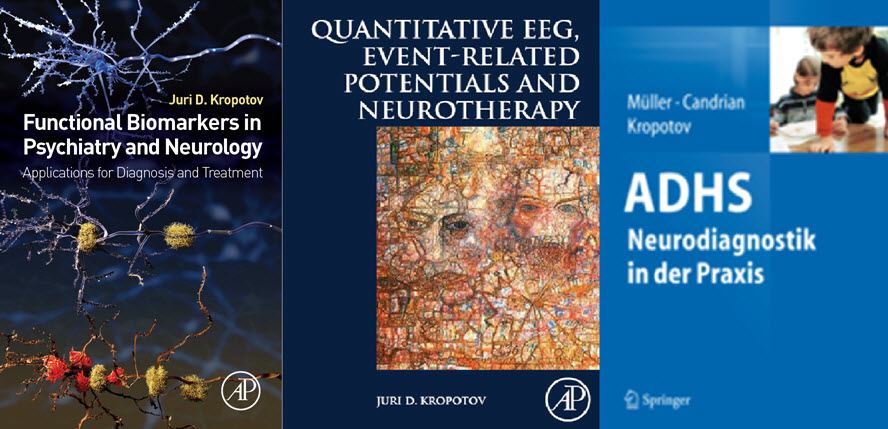Description
While the brain is ruled to a large extent by chemical neurotransmitters, it is also a bioelectric organ. The collective study of Quantitative ElectroEncephaloGraphs (QEEG-the conversion of brainwaves to digital form to allow for comparison between neurologically normative and dysfunctional individuals), Event Related Potentials (ERPs - electrophysiological response to stimulus) and Neurotherapy (the process of actually retraining brain processes to) offers a window into brain physiology and function via computer and statistical analyses of traditional EEG patterns, suggesting innovative approaches to the improvement of attention, anxiety, mood and behavior.
The volume provides detailed description of the various EEG rhythms and ERPs, the conventional analytic methods such as spectral analysis, and the emerging method utilizing QEEG and ERPs. This research is then related back to practice and all existing approaches in the field of Neurotherapy - conventional EEG-based neurofeedback, brain-computer interface, transcranial Direct Current Stimulation, and Transcranial Magnetic Stimulation - are covered in full. Additionally, software for EEG analysis is provided on a companion web site so that the theory can be practically utilized on the spot, and a database of the EEG algorithms described in the book can be combined with algorithms uploaded by the user in order to compare dysfunctional and normative data.
While it does not offer the breadth provided by an edited work, this volume does provide a level of depth and detail that a single author can deliver, as well as giving readers insight into the personal theories of one of the preeminent leaders in the field.
Readership
Primary:
Neuropsychologists and clinical psychologists seeking new methods to assess brain fucntion and dysfunction and treatment of disorders.
Secondary:Advanced neuroscience students studying brain function; neurologists and psychiatrists seeking alternative diagnostic/treatment tools.

 Functional Neuromarkers for Psychiatry
Functional Neuromarkers for Psychiatry
1st Edition, Applications for Diagnosis and Treatment
The detailed summary is now available exclusively to our members - a courtesy of Prof. Yury Kropotov.
Please register as a member before following the link!
New book summary
|
This cutting edge book explores, in detail, the brain pattern biomarkers for psychiatric and neurologic disorders and how they can be used in diagnosis, determining personalized neurotherapy, and monitoring treatment results. Focuses on the analysis of EEG and ERP, and covers the functional neuromarkers for ADHD, schizophrenia, and obsessive-compulsive disorder.
Overview :
Key Features
- Identifies specific brain activation patterns that are neuromarkers for psychiatric disorders
- Includes neuromarkers as seen via fMRI, PET, qEEG, and ERPs
- Addresses neuromarkers for ADHD, schizophrenia, and OCD in detail
- Provides information on using neuromarkers for diagnosis and/or personalized treatment
Description
Functional Neuromarkers for Psychiatry explores recent advances in neuroscience that have allowed scientists to discover functional neuromarkers of psychiatric disorders. These neuromarkers include brain activation patterns seen via fMRI, PET, qEEG, and ERPs. The book examines these neuromarkers in detail—what to look for, how to use them in clinical practice, and the promise they provide toward early detection, prevention, and personalized treatment of mental disorders.
The neuromarkers identified in this book have a diagnostic sensitivity and specificity higher than 80%. They are reliable, reproducible, inexpensive to measure, noninvasive, and have been confirmed by at least two independent studies. The book focuses primarily on the analysis of EEG and ERPs. It elucidates the neuronal mechanisms that generate EEG spontaneous rhythms and explores the functional meaning of ERP components in cognitive tasks. The functional neuromarkers for ADHD, schizophrenia, and obsessive-compulsive disorder are reviewed in detail. The book highlights how to use these functional neuromarkers for diagnosis, personalized neurotherapy, and monitoring treatment results.
Readership
Psychiatrists, neuroscientists, researchers in clinical psychology and neurology
Table of Content
Introduction
Part 1 - Methods of assessing neuromarkers
Chapter 1.1 - Theory of measurement
Chapter 1.2 - Psychometrics and neuropsychological assessment
Chapter 1.3 - Functional MRI
Chapter 1.4 - Positron emission tomography
Chapter 1.5 - Spontaneous electroencephalogram
Chapter 1.6 - Event-related potentials
Part 2 - Neuromarkers of cortical self-regulation
Chapter 2.1 - Infraslow electrical oscillations
Chapter 2.2 - Alpha rhythms
Chapter 2.3 - Beta and gamma rhythms
Chapter 2.4 - Frontal midline theta rhythm
Part 3 - Information flow within the brain
Chapter 3.1 - Sensory systems and attention modulation
Chapter 3.2 - Executive system and cognitive control
Chapter 3.3 - Affective system, emotions and stress
Chapter 3.4 - Memory systems
Part 4 - Methods of neuro-modulation
Chapter 4.1 - Pharmacological approach
Chapter 4.2 - Neurofeedback
Chapter 4.3 - Electroconvulsive therapy
Chapter 4.4 - Transcranial Direct Current Stimulation
Chapter 4.5 - Transcranial magnetic stimulation
Chapter 4.6 - Deep Brain Stimulation
Part 5 - Neuromarkers in psychiatry
Chapter 5.1 - Attention deficit hyperactivity disorder
Chapter 5.2 - Schizophrenia
Chapter 5.3 - Obsessive-compulsive disorder
Part 6 - Assessing functional neuromarkers
Chapter 6.1 - Working hypothesis
Chapter 6.2 - Technical implementation
Chapter 6.3 - Testing working hypothesis: spontaneous EEG
Chapter 6.4 - Testing working hypothesis: Event-Related Proposals
Chapter 6.5 - Monitoring treatment effects
Part 7 - The State of the Art: Overview
Chapter 7.1 - Objective Measures of Human Brain Functioning
Chapter 7.2 - Rhythms of the Healthy Brain
Chapter 7.3 - Information Flow in the Health Brain
Chapter 7.4 - Current Treatment Options in Psychiatry
Chapter 7.5 - Functional Neuromarkers in Diseased Brain
Chapter 7.6 - Implementation in Clinical Practice



 Functional Neuromarkers for Psychiatry
Functional Neuromarkers for Psychiatry